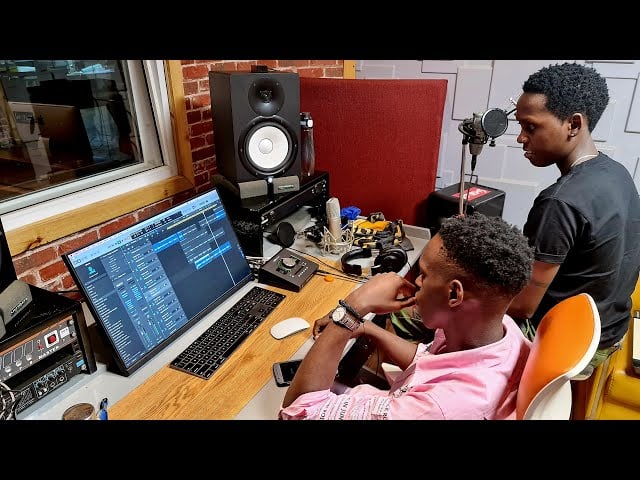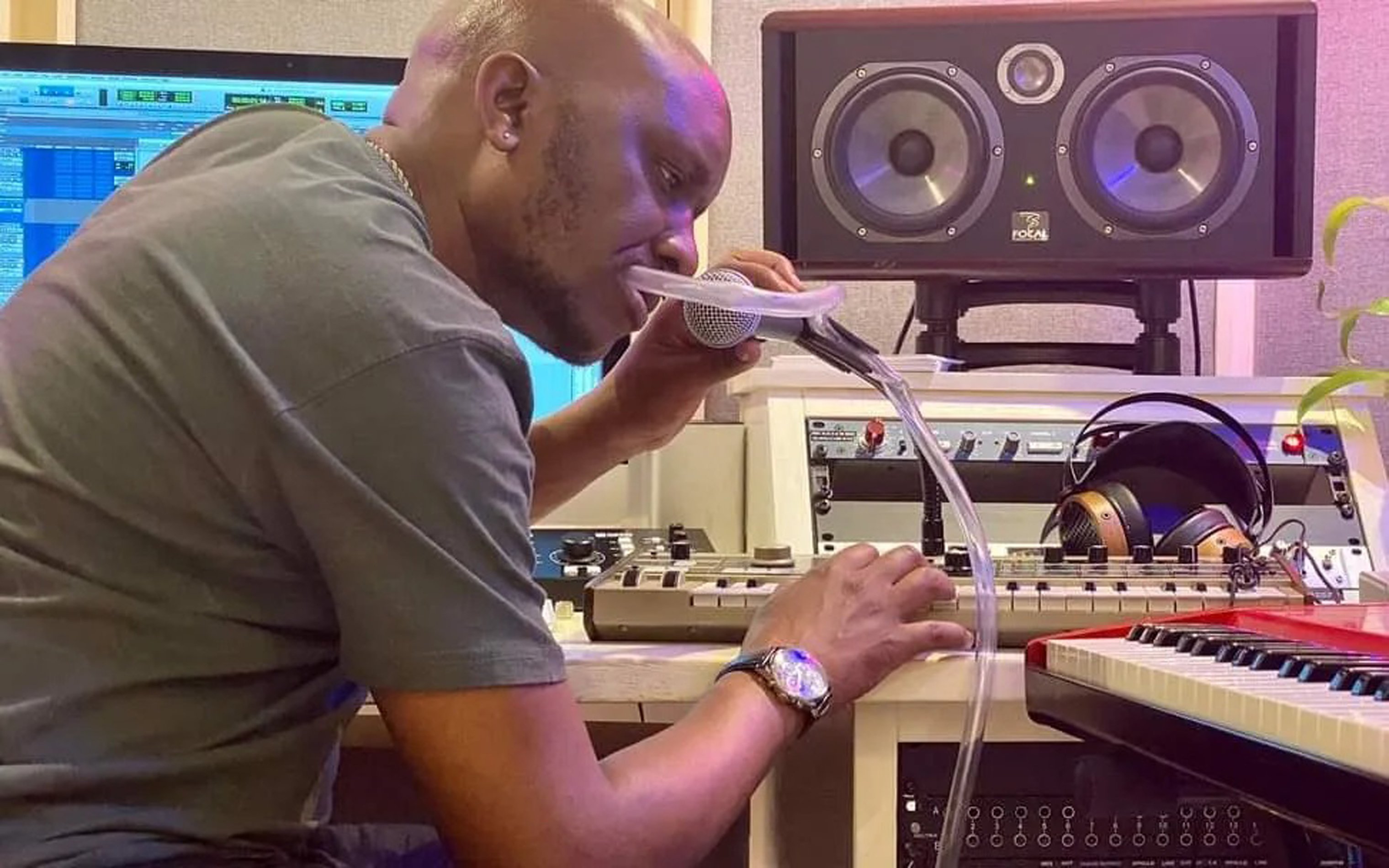Prime
The creative and technical aspects of music production

Banga Boi in studio with Azawi. Aydee says a number of things come into play when producing a possible hit song, including the current market, good marketing and packaging. PHOTO/COURTESY/SWANGZ AVENUE
What you need to know:
MAKING MUSIC: Every music producer has their way of navigating music production. Did you know a producer can hear a song and know the direction it is taking? Isaac Ssejjombwe digs into the art of music production.
Music production is the creative process of composing, recording, arranging, editing, mixing, and mastering audio to create a final piece of music. It is the journey of bringing a musical idea to life, ensuring it is ready for the world to hear. This process is guided and managed by the music producer who oversees the production of a song or album, guiding its journey from a simple idea to a polished musical masterpiece.
The producer plays a pivotal role in bringing an artiste’s vision to life, not only by intimately understanding the artiste’s aspirations but also by mastering the technical tools and musical expertise required to translate that vision into sound.

Music production creativity
Music production is both creative and technical. The creative aspects include coming up with an idea, writing lyrics and composing. The technical side of the process includes leveraging the right apps and software, editing and distributing music.
Every music producer has their way of navigating music production. According to Eddie Dumba, commonly known as Aydee from the Ngoni singing duo, the process of producing a song depends on the artiste.
He says there are songs that you hear and you straight away know the direction while other songs need you to take time and redirect the writer, give them options of different melodies, intonations etc.
“You cannot always work with what you have been given. Once you are in the same direction, lay the tracks. I prefer each step of the process to take place in its own time, hence why I cannot produce in one day. Every step has to sink in, I have to determine textures, and how the instruments are sitting with each other. My mix process starts right at the beginning. By the time we put the vocals on, I already know I have a rough mix. I usually edit the vocals as we go along, I have quick shortcuts so the artiste will not even notice. I do that between takes or breaks. Then I will need a few days to unlearn the song and approach it with a fresh mind. From there I need a few hours to mix it, then another day for mastering,” Aydee explains.
Marrick Ssekajja, aka Bangar Boi, who is one of this generation’s producers on the other hand says he first listens to what the client has in mind, asks the client to sing for him the chorus and the verses.
“Obviously when the client sings, I get a picture of how I want the song to sound in my head. I then use the melodies in his written song to create the beat and later advise the client where to change so that the song gets a whole new interesting good sounding feel and dimension,” he says.
Bangar Boi, who is also the lead producer at Swangz Avenue, has been in the game for one year and five months and in that period has managed to produce some songs, including Ndi Wuwo by Elijah Kitaka, Ten Over Ten by Azawi and most of the songs on her Sankofa album, All Over You by Vinka, Tutu Mama by Elijah Kitaka and Vinka as well as Viboyo’s Hand Made Triumph album, among many more.
He adds that every producer should have a brilliant and creative mind in order to execute song production and also have a set of music production equipment for the steady flow of their profession.

Swangz bosses Julius Kyazze and Benon Mugumbya while working in a dome on a project with Kanye West. PHOTO/COURTESY/SWANGZ AVENUE
Does music production need a time frame?
Every producer has their own way of doing things. Some will give you up to a week to get your final product but Aydee says he does not have a timeframe unless you buy his time.
“Personally it depends. It is only ready when I feel it is. The reason I do not do ‘commercial production’ is I do not work on timeframes otherwise you end up with unfinished products. However, if you buy my time and take me off everything else, a week is good for a polished product,” he says.
Asked what makes a hit song, the Nasiima Gwe artiste said a number of things have to come into play, including the current market, good marketing and packaging even before the product has been crafted, will get you a hit song.
Bangar Boi on the other hand says the time frame depends on the creative and the kind of song being produced.
Technology
Music production can be done in a professional studio setting or at home with Digital Audio Workstations (DAWs) and virtual instruments.
A digital audio workstation is an electronic device or application software used for recording, editing and producing audio files.
In modern music production, DAW has become the music producer’s canvas, a central software platform containing all the sounds, instruments and tools they use for recording music.
For Aydee’s case, he has used almost all DAW but says software does not determine his output.
“I have used just about any DAW ever made. For me the software does not determine my comfort or end product, it is the workflow. For example, I can finish a kidandali track in Reason, if I need to mix an orchestra, I will use Nuendo, and given stems, I will use Pro Tools or Luna. If starting on a melodic song, I will use Cubase,” he says.
He adds that there is hardly anything new; the technology was always there. Midi was introduced in 1980, which is the basis on which 95 percent of pop tracks are produced. The only difference is that software is now cheaper and easily pirated.
“We went to school to learn the trade, now school is YouTube at the cost of data.”
Outdoor production
Ugandan Hip Hop artiste Daniel Kigozi has just released an 11-track album titled Navio X Project.
This is the first Cultural Hip-Hop album, a testament to the fusion of tradition and innovation where the artiste takes listeners on a musical journey that pays homage to Uganda’s diverse cultural heritage and some of the songs on this album include Tyabu Tyabu featuring Nile Beat, Nangoria Ft Giraffe Clan, Joy Ft Ayesiga, The Mountain, Lidembe, Ekori Ft G-Willz 7 Giraffe Clan, Atengo Mwana Ft Haruna Walusimbi & Abaasa, Odoch Otiene Ft Gulu Dance Masters, Ndabaho and Sebei.
The artiste together with his team traversed different parts of Uganda and recorded songs that were compiled on this album. Different from his other albums and projects, this entire album was not recorded in the studio.
“The adventure part of it was interesting because we did not use any studio while producing it. We just captured sound in its purest form,” the Ngalo hit maker revealed during a press conference.
Speaking to the main producer of the album Frank Amanya alias Baru, he revealed that most of the time they had to move with a whole studio setup which could handle a group recording. They moved with a laptop, an audio interface, close to 10 microphones and a set of monitoring speakers. For areas where they went and recording was spontaneous, he had a handheld recorder for sample collection. They also used a Neumann u87 microphone as their main vocal microphone.

Banga Boi in studio with Azawi. Aydee says a number of things come into play when producing a possible hit song, including the current market, good marketing and packaging. PHOTO/COURTESY/SWANGZ AVENUE
Asked about the whole experience of recording out of the studio, he said it was different but also a learning experience.
“Personally it was a learning experience, considering we had to apply all the knowledge we have gathered in studio recordings to be able to handle recordings which were mostly outdoor. But overall it was a great experience, considering we were capturing these traditional samples in their purest form. It also came with a lot of challenges and unpredictability, which was exciting,” he explained.
About the challenges, the producer who is also a mixing and mastering engineer said working outdoors in an uncontrolled environment was the biggest challenge, considering there are a lot of things you cannot control.
“For example, it was raining when we were collecting samples at Itanda Falls in Jinja and imagine having to use all that expensive equipment in those conditions.”
In regards to comparing indoor and outdoor recordings, Baru says each requires a different approach because the conditions are different.
“Working on a studio project might be easier because you have control over a bunch of facts whereas an outdoor one is a whole different ball game because every location presents different conditions. It requires a lot of flexibility,” he adds.
In 2018, American artiste Kanye West and his family came to Uganda and one of the reasons the American multi-award winning artiste decided to come was to complete Yandhi, a studio album he said would incorporate “sounds that you have never heard before” and “concepts that people do not talk about.”
Speaking of his trip to the continent, Kanye West said he just needed “to go and even find out what it is really called and just grab the soil and be, and cook food, five meals a day so the metabolism stays up,” as well as “have the mic in the open so you can hear nature while we are recording.”
Production house Swangz Avenue was entrusted with this project and they erected a white dome with clear windows that housed the entire studio with beautiful views of the Ugandan greenery.
Speaking about this whole experience, Julius Kyazze from Swangz Avenue said they had not done anything like that before but when Kanye’s request came through, they had to do it.
They set up four recording studios which were working all the time. Because of the production demands, they had to outsource some equipment locally from different people, including cables from other studios.
“The thing with Kanye is that impossible is nothing. He is the kind of guy who wakes up and says, “This is beautiful, but I need another studio.” It was new but we embraced the challenge. We have an attitude of doing different things, and we met a guy who does impossible things. The dome and everything is what we are going to borrow actually,” he spoke about the outdoor studio they set up.




